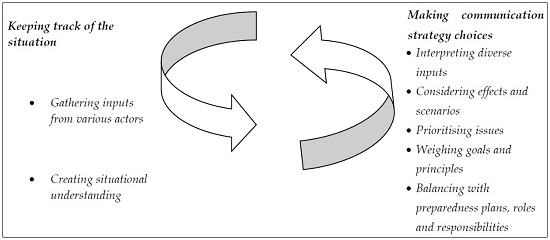
This paper aims at clarifying a timely topic of how communication strategy choices are made in evolving, complex crises, such as those caused by terrorism involving chemical, biological, radiological, or nuclear (CBRN) agents. This is done by examining data gathered from a table-top discussion among crisis communication experts, focusing on a scenario of an anthrax attack and analysed qualitatively. The communication experts followed the evolving crisis situation by gathering inputs from various actors in the crisis management network, thereby creating situational understanding, and interpreted these inputs for decision-making on communication strategies. The underlying process of coping with complexity in evolving CBRN terrorism crises can be described as a continuous, dynamic process that can best be explained with a combination of traditional and more modern crisis communication approaches. Strategy-making in crisis situations by communication experts is still largely a black box. In this study, a novel approach of decomposing strategy-making by observing a table-top discussion is chosen to clarify the process. By identifying the core elements involved, a more detailed picture of communication strategy-making is created, thus promoting preparedness and professional resilience in the field.
from #Medicine via ola Kala on Inoreader http://ift.tt/1Wujxay
via
IFTTT
Δεν υπάρχουν σχόλια:
Δημοσίευση σχολίου
Σημείωση: Μόνο ένα μέλος αυτού του ιστολογίου μπορεί να αναρτήσει σχόλιο.